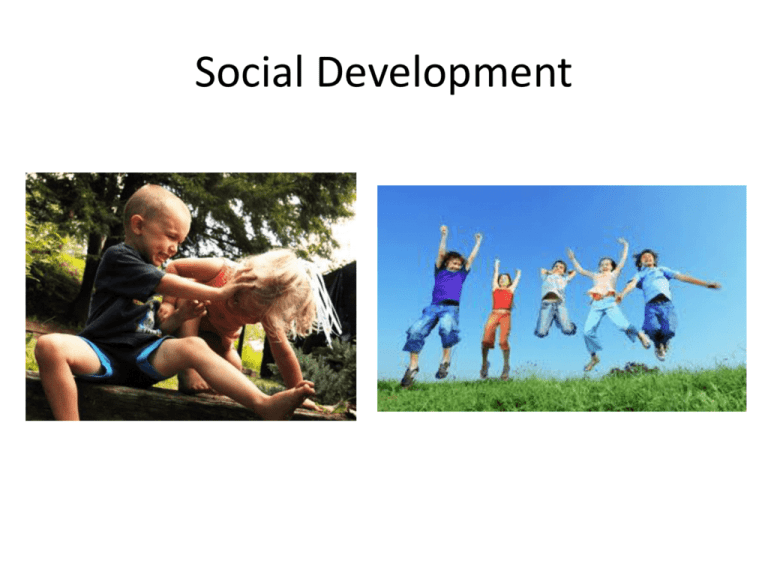Developmental Psychology - AP Psychology Community
advertisement

Social Development Social Development • Up until about a year, infants do not mind strange people (maybe because everyone is strange to them). • At about a year, infants develop stranger anxiety. • Why do you think it starts at about a year? Examine attachment in childhood and its role in the subsequent formation of relationships Attachment • The most important social construct an infant must develop is attachment (a bond with a caregiver). • Lorenz discovered that some animals form attachment through imprinting. Attachment • Harry Harlow and his monkeys. • Harry showed that monkeys needed touch to form attachment. Click the monkey to see a video of Harlow’s experiment. Attachment • Critical Periods: the optimal period shortly after birth when an organism’s exposure to certain stimuli or experiences produce proper development. • Those who are deprived of touch have trouble forming attachment when they are older. Click on the monkey to see what a baby monkey does when he HAS attachment and imagine what it is like when he does not (like above). Bowlby's Inner Working Model • Child develops cognitive model (IWM) based on quality of early parentinfant interaction • This model influences one's expectations about self and relationship with others • • e.g., secure child has developed an internalized view of self as lovable and others as caring and trustworthy e.g., maltreated child has developed view of self as unlovable and of others as not dependable Mary Ainsworth and her Strange Situation • carried out the Ganda Project which was an observational study of 28 mothers interacting with their child performed in Uganda over nine months (longitudinal). • The observations were naturalistic (in the family living room). Mary Ainsworth and her Strange Situation • She determined that maternal sensitivity to the infant’s signals and needs as these were considered to be important factors in the development of attachment. • Ainsworth replicated the study in the USA in 1971 with 26 families. “The Strange Situation paradigm”, • a procedure with several sequences performed in a laboratory to test a child’s attachment pattern to the mother. 1. the child’s reaction to the mother’s departure 2. how the child reacts to her when she returns 3. how the child reacts to a stranger Types of Attachment • Three types of attachment: Secure Attachment • (type B) • 70% of American infants • The infant shows distress when the mother leaves the room and quickly seeks contact with her when she returns. • The infant is easily soothed by the mother. Ambivalent attachment • (type C) • 10% of American infants • The infant shows distress when the mother leaves the room. • The baby seeks contact on her return but at the same time rejects it. Avoidant attachment • (type A) • 20% of American infants • The infant does not show distress when the mother leaves the room and avoids contact when she returns. • The baby is not afraid of a stranger. https://enjoypsych.wikispaces.com/Examine+attachment+in+childhood+and+its+rol e+in+the+subsequent+formation+of+relationships. Continuity in attachment patterns in romantic love • Does your attachment style when you are a baby relate to the love you feel as an adult? • Hazan and Shaver (1987) suggested that romantic love is an attachment process which is experienced differently by different people because of variations in their attachment histories. Hazan and Shaver • People have formed “inner working models” of themselves and social interaction with partners based on their attachment history. • These inner working models are an important source of continuity between early and later feelings and behavior. • In other words…we are reliving our childhood bonds in our adult romantic relationships. Hazan and Shaver Aim To investigate: 1. whether the same distribution of childhood attachment patterns was manifested in a study on adult love relationships 2. whether the difference in attachment patterns could be linked to different attachment histories 3. whether respondents’ descriptions of their love relationships could be classified as secure, avoidant, or ambivalent. Procedure • • • The first was a “love quiz” (survey with forced choices) in a local newspaper. The researchers used 620 participants (205 males, 415 females, mean age 36, 91% were heterosexual). The questionnaire included statements characterizing the most important love relationship and childhood relationship with parents (attachment history). Ainsworth et al.’s (1978) attachment categories were translated into terms appropriate to adult love. It was assumed that beliefs about romantic love could be measured as an “inner working model”. When it comes to Romantic Relationships… Results • Around 56% of the respondents classified themselves as secure • found in relatively easy to get close to others • described their relationships as trusting • Rarely worried about being abandoned • Reported much fewer divorces • About 20% described themselves as anxious/ambivalent • Showed a preoccupation of with love accompanied by expectations of rejection • Described their relationships as volatile and marked by frequent jealousy • About 24% were classified as avoidant adults. • They found it difficult to get close to others • Described their relationships as lacking intimacy and trust. Hazan and Shaver • Romantic Love is an attachment process. • Our intimate relationships follow the same patterns of attachment as in infancy. Hazan and Shaver • So a person who had an Ambivalent attachment as a baby will tend to have romantic relationships marked by anxiety and ambivalence. • So basically…people relive their early bonding with their parents in their adult romantic relationships. Parenting Styles • Authoritarian Parents • Permissive Parents • Authoritative Parents






